The Basics of RoofPoint
The RoofPoint Guideline for Environmentally Innovative Low-Slope Roofing is organized into five areas that represent the primary environmental contributions of modern low slope roofing systems:
- Energy Management — 50 points
- Materials Management — 16 points
- Water Management — 7 points
- Durability/Life Cycle Management — 22 points
- Environmental Innovation in Roofing — 5 points
CEIR then takes each of the above areas and assigns credits based upon primary environmental functions. Credit is awarded to installations using the following considerations:
•Intent — The intended result for each credit is stated in terms of a desired environmental performance outcome.
•Requirements — The effective fulfillment of the intent is identified as a measurable objective. Some requirements may be identified as Prerequisites that must be met for consideration under the Guideline. In addition, some requirements may identify different levels of performance covered by the Guideline.
•Technologies and Strategies — A brief discussion of technologies and practices available to meet the requirements is provided.
A sum total of 100 points is available; depending upon the traits of any given roofing system, a facility can be eligible for seven different award categories. (See "The Certification Breakdown on this page.) For example, if a roofing system installation scores 45 to 49 points, it is awarded the "basic" category. Those installations with 65 points or higher earn the "platinum plus" category.
Silvertooth says a pilot program will be rolled out later this year, and that the test sites comprise a range of industries. Early adopters are likely to include retail chains, REITs, large property managers, plus federal and state agencies with large property inventories.
Two Key Elements
Although five elements exist within the RoofPoint guidelines, two of them — energy management and durability — are weighted significantly more than the other three, reflecting the importance of both to the guideline's founders. Also of note is the importance of rooftop energy generation, covered below in energy management.
The intent of the emphasis on energy management is to help roofs achieve levels of energy performance beyond the prerequisite standard.
More specifically, the energy management section of RoofPoint guidelines call for an increase in roof R-values; reduction of thermal discontinuities in the roof plane; installation of cool roof surfaces; installation of an air/moisture barrier; installation of solar/wind energy generation; and utilization of daylighting. Obviously, not all of the strategies need to be incorporated into a retrofit, though some are weighted more heavily.
Take for example the installation of solar/wind energy. Facility managers who implement energy generation on their rooftops will receive up to 10 credit points, whereas air/moisture barriers or daylighting installations only receive four credit points.
Why is that? Hoff cited the Energy Policy Act of 2005 as one clear impetus.
Because the act establishes a goal for the United States to have net-zero energy commercial buildings by 2030, roofing experts see rooftop energy generation as one possible solution.
"The net-zero goal is unattainable without a significant change in the way we design, construct and use the nation's rooftops," says Hoff. "Roofs must become much more energy efficient and must serve as a dependable platform for the production of clean energy for us to have any chance of meeting this goal."

Related Topics:














